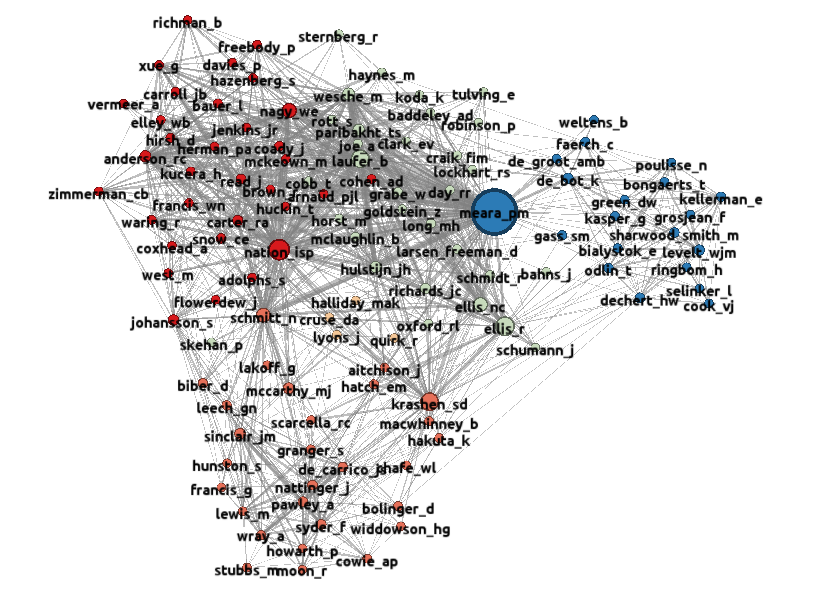
_lognostics maps
Applied Linguistics 1980-2010

data source: Applied Linguistics 1980-2010: data analysis: March 2014
data: 60 papers, 116 nodes, 1142 co-citations, 5 clusters
threshold for inclusion: Authors must be cited in at least five different papers; co-citations must appear at least three times.
This map shows displays the vocabulary related papers published in Applied Linguistics between 1980 and 2010.
116 authors are cited in at least five papers in the 2006 data. The nodes in the map are sized according to each author's betweenness centrality. This is a measure which tends to favour people who are frequently co-cited with people outside their own immediate circle of references. The sources that score most highly on betweenness centrality in Applied Linguistics are Meara, Nation, R Ellis, Laufer, Krashen, Nagy, N Schmitt, NC Ellis, Wesche and Paribakht.
The analysis identifies into five clusters.
Cluster I, centred on Nation and Nagy, contains a total of 33 sources. It seems to be mainly concerned with L2 reading behavior and the acquisition of vocabulary from texts. There are, however, some other concerns in this cluster notably a vocabulary depth strand, and a strand concerned with Academic Vocabulary. The members of this cluster are: Adolphs, RC Anderson, Arnaud, Bauer, R Brown, JB Carroll, Carter, Coady, Cohen, Coxhead, Davies, Elley, Francis, Freebody, Hazenberg, Herman, Hirsh, Huckin, Jenkins, Johansson, Kucera, McKeown, Nagy, Nation, Read, Richman, Snow, Vermeer, Waring, West, Xue, and Zimmerman.
Cluster II, consisting of 28 sources, is a cluster whose main concerns are corpus linguistics, semantics, and metaphor. Researchers interested in formulaic aspects of vocabulary also appear in this cluster. The members of this cluster are: Aitchison, Biber, Bolinger, Chafe, Cowie, de Carrico, G Francis, Granger, Hakuta, Hatch, Howarth, Hunston, Krashen, Lakoff, Leech, Lewis, Macwhinney, Moon, Nattinger, Scarcella, N Schmitt, Sinclair, Stubbs, Syder, Widdowson and Wray. Krashen appears to be a somewhat anomalous member of this group.
Cluster III is the very small central cluster that includes Cruse, Halliday, Lyons and Quirk. This group seems to be a set of "classical" linguistics sources who were mainly active in the UK in the 1970s and 1980s.
Cluster IV, consisting of 31 sources, is focussed on R Ellis, Laufer, Wesche and Paribakht. This cluster, which has very strong links with Cluster I, seems to be characterised by a strong emphasis on empirical studies of vocabulary learning. It is, however, less concerned with reading than cluster I is. Significant sub-themes within this cluster deal with memory, lexical inferencing and language aptitude. This cluster also includes a number of sources who are Big Names in Second Language Acquisition, but not particularly active as researchers in L2 vocabulary. In general, this cluster is more concerned with theory and less concerned with practical applications than Cluster I is. The members of this cluster are: Baddeley, Bahns, EV Clark, Cobb, Craik, NC Ellis, R Ellis, Goldstein, Grabe, Haynes, Horst, Hulstijn, Joe, Koda, Larsen-Freeman, Laufer, Lockhart, Long, McLaughlin, Oxford, Paribakht, Richards, Robinson, Rott, R Schmidt, Schumann, Skehan, Sternberg, Tulving and Wesche.
Cluster V, is a group of twenty sources, mainly European psycholinguists, whose main focus is on the performance of bilinguals. This cluster has a very strong empirical bias, and has relatively few links with the other clusters in this map. The members of this cluster are: Bialystok, Bongaerts, Cook, de Groot, Dechert, Faerch, Gass, DW Green, Grosjean, Kasper, Kellerman,Levelt, Meara, Odlin, Poulisse, Ringbom, Selinker, Sharwood Smith, and Weltens.
Points to note in this map include the very dense connections between cluster I and cluster IV. Cluster II is loosely connected to these main clusters, but only a handful of co-citations link cluster II with cluster V. The majority of the Significant Influences in this map belong to cluster IV.
Meara's dominant position in this map is due to two factors. Firstly, he is heavily co-cited alongside a number of members of Cluster V, whereas the other major figures in Cluster I and Cluster IV tend not to be co-cited in this way. Secondly, some of Meara's work was the subject of two highly critical papers published in Applied Linguistics by Laufer and by Bogaards. These papers significantly increased Meara's co-citation count, but they are a good example of research being cited for negative reasons, rather than positive ones.